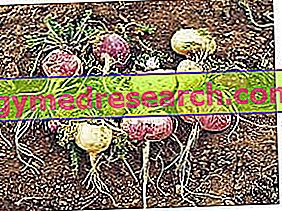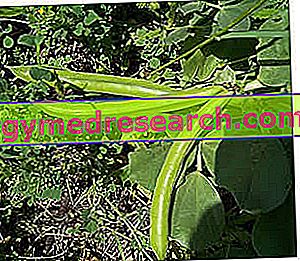Maca
Peruvian Maca or Maca (botanical name Lepidium meyenii ) is a " Ginseng plant " that includes seven "perennial" varieties, all originating in South America and more precisely in the Andean mountain crest.

During the pollination period, the Maca produces small inflorescences with 5 petals of white - straw yellow; the respective fruits are minute and with a dry consistency. At one time (since the golden age of the Incas) it was widely cultivated by the Andean people; today it is much less so and the production is limited to the Puna plateau (Pasco) and to the Junìn, between 3500 and 4500 meters of altitude. Its production determines the characteristic "soil impoverishment" which requires a fallow (rest from the crops) of about 5 years.
In light of this, it is not difficult to believe that Maca is a vegetable that is particularly "rich" in nutrients useful to the body ... even if this does not justify any "special" effect on human beings. But be careful, being a tuber, the Maca does NOT consume the leaves (wider at the base and smaller towards the apex), but the small roots and the attached fleshy portion that - it is rumored ... - besides being edible, if consumed correctly, FERTILITY would increase in both women and men.
Eat Maca
Maca tuber is consumed both fresh and dehydrated; fresh Maca is boiled or roasted, while dried Maca (in the sun for a whole month!) can be found in water and consumed as fresh, or powdered to become an essential ingredient in sweets and / or alcohol.
Chemistry and composition of Maca
The pre-Columbian civilizations, between the 13th and 16th centuries, cultivated Maca on the Peruvian plateau because of its high energy density and the intense overall nutritional value of the drug (tuber and roots).
Maca (based on the variety) contains a protein portion that fluctuates between 10 and 18g per 100g of edible portion (while the rest of the energy is supplied by carbohydrates and lipids); the peptides it contains are of medium biological value and are composed of discrete quantities of essential amino acids such as: leucine phenylalanine, lysine, valine, isoleucine, threonine, methionine and histidine. This characteristic has made the Maca a tuber to say the least indispensable since, on the Andino plateau, foods of animal origin (containing proteins with high biological value) are not particularly easy to find ... to the detriment of the overall protein quality. It is assumed that the association of Maca with other foods containing the related limiting amino acids could complete the essential amino acid pool by balancing the diet of the settled populations.

Also of note is the average contribution of mineral salts, including both micro and macro elements; Maca contains excellent amounts of: potassium (K - 2050mg per 100g), calcium (Ca - 150mg per 100g), ferric or trivalent iron (Fe3 + - 16.6mg per 100g), copper (Cu - 5.9mg per 100g), zinc (Zn - 3.8mg per 100g); sodium (Na) and manganese (Mn) not determined. The vitamin content of Maca is also not negligible, which particularly favors the water-soluble ones of group B.
Curiosity : In Maca there are also typical and exclusive molecules of this tuber, macaridins (benzylated derivatives of 1, 2-dihydro-N-hydroxypyridine) and macamids (alcamids benzialti); Maca essential oil contains phenyl acetonitrile, benzaldehyde and 3-methoxyphenyl acetonitrile.
Property
Maca has always been considered (like the other Ginseng) a tuber with exceptional characteristics; in addition to the various nutritional aspects already listed, tonic, aphrodisiac, fertility and adaptogenic properties are attributed to it, but conclusive studies are not yet available that demonstrate the indiscriminate beneficial action nor the mechanism of action on increasing fertility.
Use of Maca
Maca is an essential ingredient of Peruvian ethno-medicine, and traditions are not to be underestimated.
Maca can be useful as a "tonic" in sports integration and as a supplement to low-calorie slimming diets, but the consumer does not necessarily expect miraculous results; its effect is quite subjective and, if for some it seems irreplaceable, for others it is worth little more than a glass of water.
Maca is also recommended due to its aphrodisiac potential and increased fertility observed in some Peruvian studies; the suggested dosage is about 1.5g of purified extract to be divided into 3 administrations: morning, afternoon and evening on a full stomach.
Science in favor of Maca
On the male man
The administration of Maca has improved sperm production and sperm mobility in DOSAGE AND HOMONIAL AXIS. A subsequent study compared Maca to a placebo and again obtained positive results on DESIRE and independent of the hormonal axis.
On the female rat
Older studies have reported an increase in fertility in the female rat, associated with an increase in estrogen and follicular stimulation.
On the male rat
The same work, but on male rats, observed an increase in spermatogenesis and ejaculation, while the high maca dosage seems to significantly reduce the inter-patient interval. Ultimately, from an in-depth analysis of the male rat, an increase in desire, sperm production and, in those with erectile dysfunction, a reduction in the latent period of erection can be seen.
Side effects
The use of Maca is contraindicated in pregnancy and lactation but in the subject SANO has not shown any side effects of any kind.



